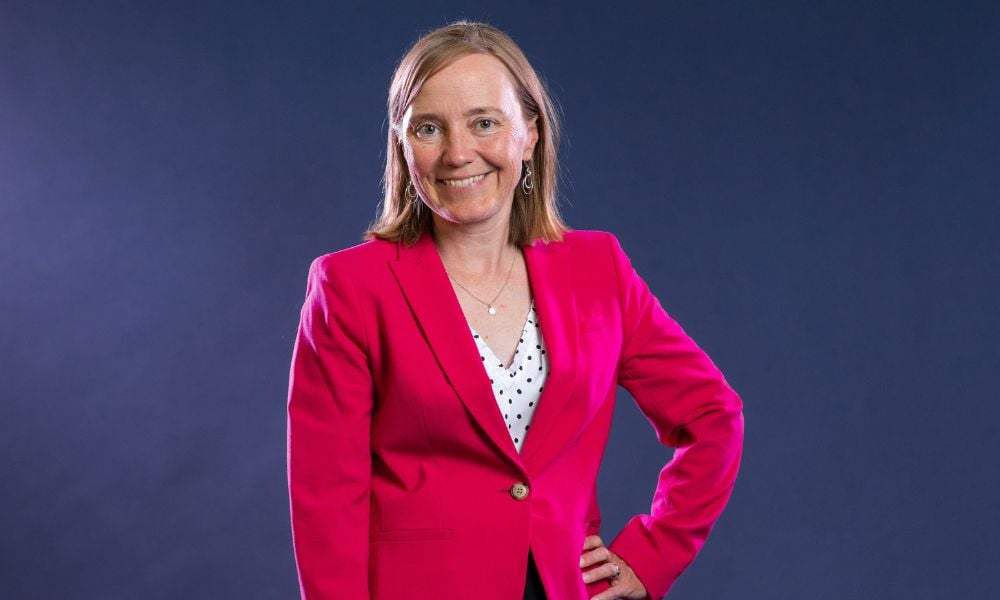
Olympian brings unique approach to legal challenges, navigating complexities in higher education

Perched in that unique intersection between the legal sphere and education, Amy Nixon says many elements are out of an individual’s control. As Mount Royal’s general counsel and university secretary and as a former competitive athlete and Olympian, she tells Lexpert that it’s both a challenging and fascinating place to be.
“I call it a maddeningly beautiful place,” she explains. “There's a number of injects or intersections with things that are outside of your control – and for good reason. There's a lot of government interest in higher education; there are external and internal community members; there are lots of different perspectives that we have, including the intersection of a labour relations environment.”
All the different layers add a level of complexity rarely seen in other industries. For Nixon, she cites the challenge of marrying academic freedom, free expression, and conduct processes across the sector as a particular pressure point.
“You have challenges in that space [which] by their nature engages the interest of government, it engages the interest of business communities, faculty members, potentially of students and other employees. The number of different perspectives that you have to engage with when you work in a university is both invigorating and at times uniquely challenging.”
As an Olympic bronze medalist, Nixon represented Canada as a curler in Turin’s 2006 Winter Olympics. She says this has also honed her legal skills. Her job is a blend of unpredictability and diversity, akin to her days as a competitive athlete.
“One of the cool things about my job is the complexity and the diversity of the things that we get to work on – and people we get to work with… Every day, I walk onto campus, and I don't know exactly what's going to happen. There's an intersection there with me as a former competitive athlete – and I love that about my job.
“My love of curling and my passion and my commitment to curling over many years really informed my legal career,” adds Nixon. “It resulted in me taking positions as a younger lawyer that allowed me to curl, which meant that I have a patchwork quilt background in law to some extent. However, I do think that curling has informed the reasons why I ended up in the university environment. I'm an executive member, I engage across senior leadership, and I bring a unique perspective on team function and leadership.”
Nixon draws an analogy, comparing her role's legal, risk, security, and emergency management aspects to firefighting. She explains that during crises, her team acts as "firefighters," swiftly addressing urgent matters. In contrast, the governance and policy dimensions involve strategic planning—more akin to home improvements.
“We're renovating the house,” says Nixon. “We're thinking about what we want to add to the house and how we might want to decorate it in a way that is warm and welcoming or creates the right kind of team environment. And that that is really unique. Because I have both sides of my job, I get to work with very different people.”
While Nixon finds that juxtaposition challenging in her role, it’s also exciting, giving her a wider perspective.
“I get a really broad cross-institutional lens; I really know what's happening in various areas of campus and across various committees and leadership decisions. I think it provides me with a unique opportunity to really guide us as an advising function. We’ve been able to integrate [this] because of our cross-institutional knowledge and some of our, frankly, cultural competency in the environment as trusted people who have the best interests of the university at heart.”
Nixon says this aspect of her role requires a deep commitment to the university’s unshakeable values.
“You don’t come and work in a university environment without a heart pull,” she says. “There has to be a reason why you are aligned to the value of universities and their importance in our society.”
Looking ahead to her own career goals and the sector at large's future, Nixon sees a mixture of policies and putting people first.
“Between risk management processes and employee wellness – we’re seeing both of those align with the university’s strategic plan. They’re also aligning from a governance lens. It’s one of the key oversight obligations of a board – trying to make sure that we’re continuously fostering the key conversations that need to happen around risk at the senior leadership levels.
“We've seen across many sectors in the last four years since most of us were stuck at home in a pandemic environment, that employee wellness has shifted in hybrid or remote work environments. We know in our environment, at least in higher education, that mental health is one of the key elements of concern for students and for employees.”